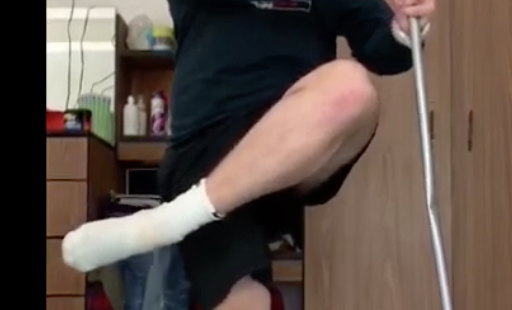There will be several articles included in this “Common Cues” series. Below are some important notes to consider before we get into the actual article (these will be included at the beginning of each article in the series):
- Cues are not the same as reality. Cues create reality. Therefore, some of the cues will not match reality, or in other words, what actually happens. Their purpose is to create the reality, not be it.
- Every cue is not meant for everybody. There will be a list of examples in each article, detailing athletes that both demonstrate characteristics of the cue, and athletes that don’t. It’s tough to say exactly which athletes the cue will or won’t work for. Let your intuition be the measuring stick. If the cue makes sense to you, try it out. If not, move on.
- Over time there will be a growing list of “Common Cues” articles. To search for these, simply click the 3 little bars you see at the top of the site and enter “Common Cues” into the search bar to get the full list.
- Let’s get started.
Many of the Common Cue topics covered thus far have been related to the lower half, and with good reason. Our connection with the ground is an essential element when it comes to maximizing our swing efficiency. Losing connection with the ground means losing our ability to control our swing. And losing our ability to control our swing, is no bueno.
And that’s why we’ll be covering yet another lower half cue today, known as Leave the Cone Alone.
What’s it Mean?
Imagine you’re in your hitting stance and there’s a cone setup several inches inside your rear leg. This imaginary cone goes up to roughly knee height and is made of a precious glass that shouldn’t be broken. Your job is to get to swing initiation without breaking the glass… and then once your swing is initiated, your job is to smash the glass into a thousand little pieces. So really this cue should be called “Leave the Cone Alone.. Until Swing Initiation”, but who’s gonna read an article with a title like that?
Anyway, this is what I mean. Notice Story’s rear leg here. Imagine he has that imaginary cone sitting inside his rear leg. How long would he go until his rear knee rotated and broke it?
Here’s another video, broken up to help you see it a little more clearly:
We see Story “holding on” to his hip abduction and external rotation all the way up until the point in time that his hands start moving forward.
To clarify, “hip abduction” is when you move your femur away from the midline of your body:
And hip “external rotation” is when you rotate your femur away from the midline of your body:
We can see Story holding onto both of these actions as he makes his forward move towards the pitcher. So the technical way of saying “Leave the Cone Alone” would be “maintain your hip abduction and external rotation”, but I’m not sure how many athletes that would resonate with, so we’ll stick with the cue.
Assess
Moving forward, your swing won’t be able to cash a check that your body can’t write, so we need to make sure you have adequate amounts of each of these actions before giving you a cue and getting mad that you aren’t executing it “properly”.
Hitting requires far less hip abduction than does high level throwing, so it’s very unlikely that you’re deficient in that area. So we’ll focus on hip external rotation.
Here’s the hip ER assessment I put all our remote athletes through during their initial physical evaluation with us:
Generally, you’re going to want close to 45 degrees of external rotation at the hip, and you’re going to want nearly the same amount of active range of motion as passive. If you don’t have that, there are training methods we can employ to work on it, but that’s a deep hole and is outside the scope of this article.
For now, just know that if you don’t have those ranges of motion, you’re either going to want to 1) work on increasing your joint ROM, or 2) build your swing around the range of motion you already have. Most likely, you’ll want to do a combination of those two things.
Application
So now that you know what the cue means, and you know whether your body is able to cash the check that this cue writes, how can you actually go about implementing it?
To start, you may want to make some small foot placement adjustments based upon your hip ER range of motion. If you’re a guy that has well beyond 45 degrees of external rotation, it’s very likely externally rotating your rear foot/leg will be of benefit to you.

You can think about it like this:
A rope at any given point in time has a certain amount of slack in it. And, at any given time, there is a certain distance you would need to pull it to take that slack out. The more range of motion you have in your hip joint, the farther you have to pull that rope to take the slack out. And our bodies don’t move well when there is slack in the system. So if you’re not putting yourself in a position in which you have the ability to take the slack out of that rear hip, your performance may be suffering.
What externally rotating your foot will do, is lesson the distance you have to “pull” to take the slack out of your hip joint.
Here’s an example of Arenado demonstrating a more externally rotated foot position:
And, while I’ve never physically evaluated Arenado, I’d guess he has more hip ER than IR purely through the way that he moves. Check out his feet in this pic. Again, we can see a propensity for him to be more externally vs internally rotated:

So once you’ve identified and accounted for the amount of hip ER you have, you can now begin thinking about the cue.
*As a side note, for those of you who have more hip internal rotation than external, it is very likely this cue is not for you, as the cue is literally meant to help you create more external rotation, which you don’t have*.
At this point, we’ll turn the article over to a video I made on the subject, as I’ve found it much easier to demonstrate these cues via video. I take you through some practical actions you can take (like, I don’t know, maybe using a cone?) to help you internalize and apply what this cue represents:
As always, I hope you all enjoyed this content and that it will help you or your hitters get a little bit better. If you’re interested in learning more about how this, or any of the other cues we’ve covered, can help elevate your performance, feel free to reach out. Shoot me an email at brady@dacbaseball.com and I’ll be back in touch with you shortly.
Here’s to staying hungry,
Brady
